Banks may boost systemic liquidity by drawing down on excess cash reserve ratio and statutory liquidity ratio, said Reserve Bank of India Governor Shaktikanta Das on Friday, despite the fact that surplus liquidity in the banking sector has reduced significantly.
The banking sector’s liquidity surplus has decreased from roughly Rs 8 trillion in early April to around Rs 1 trillion in September, with the system even dipping into deficit amid advance tax outflows earlier this month.
The decline in the liquidity surplus may be attributed to a variety of causes, including the RBI’s interventions in the foreign currency market and a strong increase in bank loan growth, which is presently at nine-year highs.
Because of the declining liquidity surplus, the interbank call money rate has risen to three-year highs since last week, with the weighted average call rate currently higher than the repo rate. The weighted average call rate serves as the central bank’s monetary policy anchor.
In line with the RBI’s revised repo rate of 5.90 per cent, the weighted average call rate on Friday finished at 5.98 per cent. On Friday, the RBI raised the repo rate by 50 basis points.
“This temporary moderation of surplus liquidity needs to be seen in the context of the large potential liquidity in the system arising from the expected pick-up in government spending that usually happens in the second half of the year,” Das said while detailing the Monetary Policy Committee’s statement on Friday.
Also Read: RBI hikes repo rate by 50 bps: See what leaders across the segment stated
“Furthermore, drawdown of excess cash reserve ratio (CRR) and excess statutory liquidity ratio (SLR) holdings of banks can also augment system liquidity,” he said.
The cash reserve ratio (CRR) refers to the amounts that banks are required to deposit with the RBI. The current ratio is 4.50 per cent.
The statutory liquidity ratio (SLR) is the percentage of a bank’s deposits that must be held in highly liquid assets, typically government bonds. The current ratio is at 18 per cent.
Banks have stockpiled up on government bonds much over the permissible minimum after the RBI began an extended monetary easing cycle in the aftermath of the COVID crisis in March 2020. According to Treasury authorities, the excess SLR in the banking sector is currently approximately 9 per cent of deposits.
Elets The Banking and Finance Post Magazine has carved out a niche for itself in the crowded market with exclusive & unique content. Get in-depth insights on trend-setting innovations & transformation in the BFSI sector. Best offers for Print + Digital issues! Subscribe here➔ www.eletsonline.com/subscription/






















